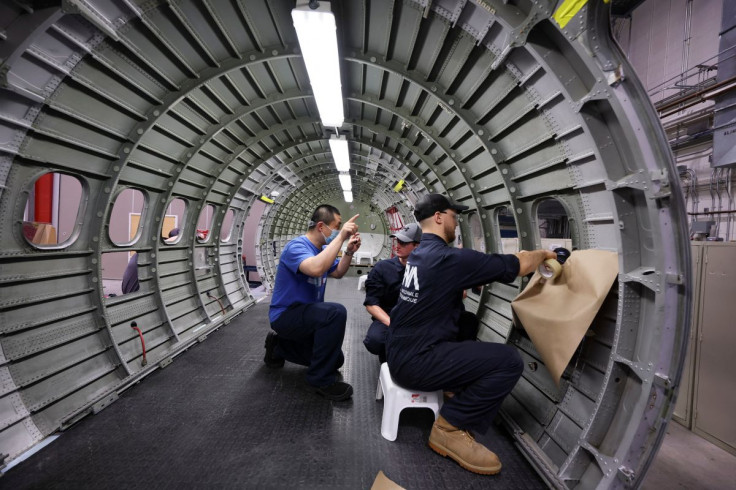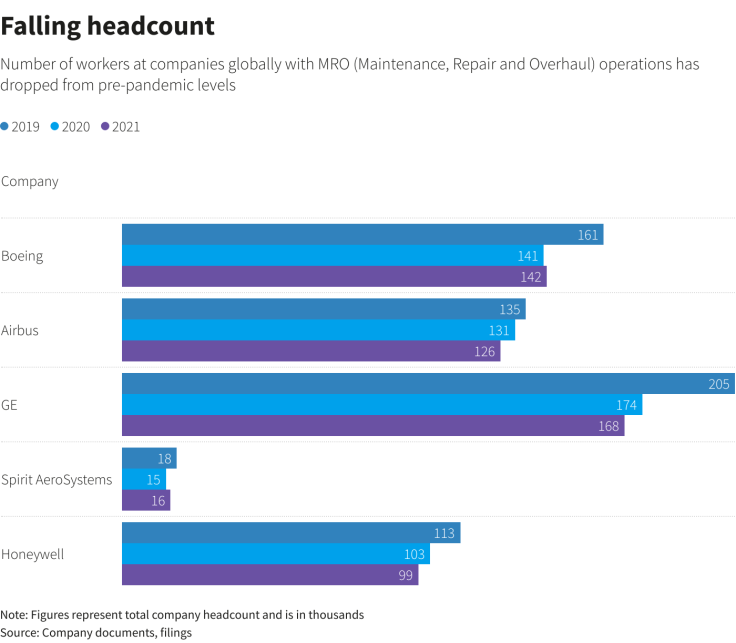Aviation Sector Faces Hiring Headache As Mechanics Shortage Looms

Christophe Gagnon considered quitting his avionics studies as COVID-19 crippled aviation, but the 21-year-old stayed in class and now the industry is desperate for more like him to keep planes flying.
Two years after lockdowns nearly grounded the airline industry, repair shops and suppliers are scrambling for students like Gagnon, who received multiple job offers while still at the ?cole nationale d'a?rotechnique (?NA) in Canada's aerospace hub, Quebec.
The hiring rush is evidence of a sharper than expected recovery in air travel, but also signals a looming labor shortage that is raising costs and could push up repair times as the industry stages an awkward recovery from its worst crisis. Shortages are on the minds of executives at the Farnborough Airshow near London, this year's largest aerospace expo, which starts on July 18.
While a shortage of plane cabin staff has dominated headlines due to recent flight cancellations, finding mechanics also has executives sweating. Roughly $84 billion is expected in spending this year on maintenance, repair and overhaul of aircraft, according to Naveo Consultancy.
"We are struggling in a big way. We can't get enough (workers)," said Abdol Moabery, chief executive of commercial aerospace company GA Telesis LLC.
Despite offering raises upwards of 10%, Telesis is working harder to retain labor as soaring housing prices in the company's South Florida location lead some workers to eye offers in more affordable areas.
The high-margin services industry is attractive for planemakers like Boeing Co, as air travel rebounds. In 2021, the U.S. planemaker forecast the global industry's need for 626,000 new maintenance technicians over the next two decades compared with 612,000 pilots.
A shortage of aviation maintenance engineers, who certify an aircraft's airworthiness, could lead to cancelled flights, or delay appointments for repairs, executives said.
COVID-19 job cuts sped up a pre-pandemic trend of workers retiring or switching to other industries like automotive, and schools are not producing enough graduates to replace them.
GRAPHIC: Falling headcount

The average Federal Aviation Administration (FAA)-certified mechanic is 53, or 11 years older than the average U.S. worker as reported by the Bureau of Labor Statistics. Enrollment at U.S. aviation maintenance technician schools grew 0.55% in 2020 after COVID-19 hit, compared with 13% in 2019, according to the Aviation Technician Education Council (ATEC).
"Recruiting mechanics has become noticeably more difficult compared to the pre-crisis period," said Frank Bayer, who heads human resources at Lufthansa Technik AG.
Canada's Cascade Aerospace, which repairs military aircraft, could attract roughly 100 workers a year during the pandemic, when commercial aviation slumped and labor was available, said company executive Scott Cadwell. Now, "it's crickets out there for experienced workers."
IMAGE MAKEOVER
In Quebec, trade group Aero Montreal is planning its first industry-led campaign this fall using traditional and digital media, along with influencers, to attract more students.
Enrollment at ?NA is down 20% compared with 2019, an alarming sign for Montreal, the world's third-largest aerospace center.
"In two years, in three years, if nothing changes, if young people continue to lack interest in our sector, we won't be able to deliver our products," warned Aero Montreal President Suzanne Benoit.
A Wells Fargo survey of aircraft maintenance, repair and overhaul services providers showed the labor crunch worsening in July, with 60% of those polled saying they saw a "meaningful impact" from shortages compared with 35% in a prior survey.
Unlike pilots, who can earn salaries of up to six figures, mechanics and other trades pay less and often come with late shifts. According to an ATEC survey, the average entry-level hourly rate for a mechanic was $22.36 in 2021.
Alex Dichter, who leads consultancy McKinsey's travel, logistics and infrastructure practice, said mechanics need an image overhaul.
"If you were to poll high school students who didn't want to be doctors, or lawyers or businesspeople and ask them what they want to be ... relatively few kids talk about being mechanics," he said. "We've got a bit of catch-up to do on that front."
Lufthansa and Singapore Technologies Engineering Ltd both said they are sweetening compensation for some trades.
Constant Aviation, which services private jets, recently hiked technician pay by 10%, and introduced $15,000 signing bonuses for qualified veterans to meet soaring demand.
Booking maintenance slots, which once required a few weeks' notice, must now be made six months in advance, said Kent Stauffer, chief safety officer of the Cleveland-based company.
Stauffer said the industry hurt itself by not paying more.
"Now it's all catching up with us."
SEEKING STUDENTS
A 2022 Canadian Council for Aviation and Aerospace forecast expects a shortage of 58,000 skilled workers by 2028. Yet schools teaching maintenance, avionics and structures provide less than a quarter of needed graduates, due to limited capacity and poor completion rates.
"Industry needs to develop its own training programs because the colleges don't have the capacity to train what industry needs," said Robert Donald, the council's executive director.
Canada's KF Aerospace, which does heavy maintenance and modifications for commercial aviation, is now doubling the number of new recruits it trains from scratch, said chief corporate services officer Grant Stevens.
Such need is not lost on a new generation of workers.
Just as ?NA student Christophe Gagnon from Quebec received more than one job offer, Frederik Gagnon, who is not related but went to the same school in aircraft maintenance technology, said he had no trouble finding work.
Frederik Gagnon recalled landing a job interview less than a day after applying.
© Copyright Thomson Reuters 2024. All rights reserved.











